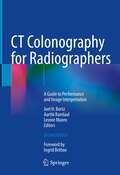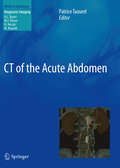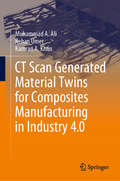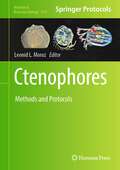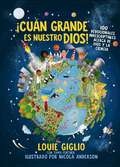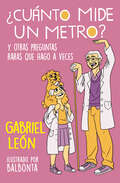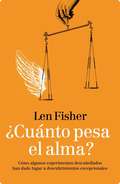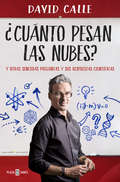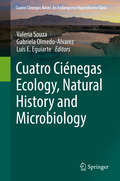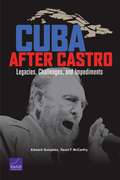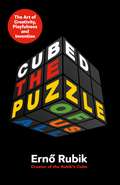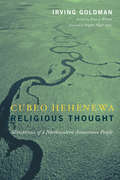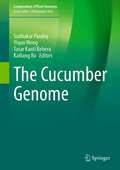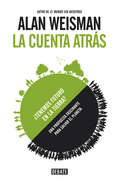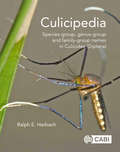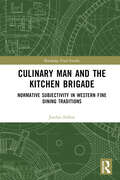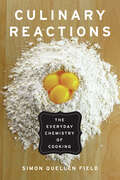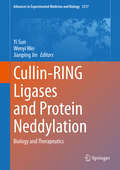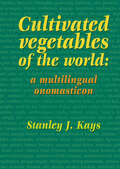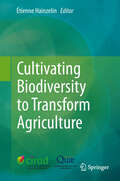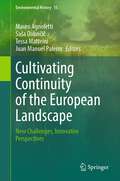- Table View
- List View
CT Colonography for Radiographers: A Guide to Performance and Image Interpretation
by Joel H. Bortz Aarthi Ramlaul Leonie MunroThis second edition, comprising 28 chapters, explains every aspect of the role of radiographers in performing CT colonography (CTC) and interpreting CTC images with the aim of enabling radiographers to extend the scope of their practice. It provides information required with respect to communication with the patient, procurement of informed consent, the principles of CT as well as dual-energy CT and photon counting CT, radiation dose, patient preparation and positioning, the use of contrast media, the performance of diagnostic and screening CTC studies, the interpretation and reporting of images, legal and professional requirements, and the importance of clinical audits.A wide range of CTC findings is described and depicted, covering normal anatomy, artefacts, haemorrhoids, polyps, colon cancer, diverticular disease, lipomas, extracolonic structures, opportunistic screening for osteoporosis and metabolic associated fatty disease, and CTC in incomplete or failed colonoscopy. The role of other modalities such as ultrasound, magnetic resonance imaging, and nuclear medicine in colorectal cancer patients is discussed. In addition, the text covers the role of artificial intelligence and machine learning in imaging of the colon for the detection of polyps, diagnosis and staging of colorectal cancer. Lastly, a chapter focusing on self-assessment of image interpretation will aid learning.This book provides the support that radiographers need in order to perform CTC studies to the standard required in terms of advances in imaging and interpretation of images.
CT of the Acute Abdomen (Medical Radiology)
by Patrice TaourelCT of the Acute Abdomen provides a comprehensive account of the use of CT in patients with acute abdomen. Recent important developments in CT, including multislice CT and multiplanar reconstructions, receive particular attention. CT features are clearly illustrated, and pitfalls and differential diagnoses are discussed. The first section of the book presents epidemiological and clinical data in acute abdomen. The second and third sections document the key CT findings and their significance and discuss the technological background. The fourth and fifth sections, which form the main body of the book, examine in detail the various clinical applications of CT in nontraumatic and traumatic acute abdomen. This book will serve as an ideal guide to the performance and interpretation of CT in the setting of the acute abdomen; it will be of value to all general and gastrointestinal radiologists, as well as emergency room physicians and gastrointestinal surgeons.
CT Scan Generated Material Twins for Composites Manufacturing in Industry 4.0
by Muhammad A. Ali Rehan Umer Kamran A. KhanThis book highlights a novel and robust platform in the form of in-situ characterization setup for creating X-ray computed tomography (XCT)-based textile material twins. In this hybrid experimental–numerical platform, XCT images of different complex fibrous reinforcements at different levels of compaction are acquired. The images are converted into computational models for resin flow simulations. The capabilities of this hybrid framework are applied to a variety of reinforcements used in liquid composite molding processes such as 2D, 3D fabrics and dry tapes. This book is a milestone in the development of virtual manufacturing protocols using material twins of textiles, providing a step closer to the digitalization of advanced composites used in manufacturing processes for industry 4.0.
Ctenophores: Methods and Protocols (Methods in Molecular Biology #2757)
by Leonid L. MorozThis volume explores emerging approaches and methods inspired by recent research using ctenophores or placozoans, facilitating the study of these enigmatic species and ancient animal lineages. Practical protocols are integrated with introductory chapters about general biology, summarizing the diversity, evolution, genomics, development, and neurobiology of these organisms. Special chapters outline strategies and applications for culturing, microscopy, physiology, electrical synapses, and bioluminescence, molecular and single-cell biology, transcription factors, as well as gene and protein expression analyses. The book also contains bioinformatics and computational chapters covering peptidomics and epigenomics. Written for the highly successful Methods in Molecular Biology series, chapters include detailed implementation advice that leads to dependable results in the laboratory. Authoritative and practical, Ctenophores: Methods and Protocols is anideal resource for comparative and experimental biologists and interdisciplinary scientists aiming to decipher fundamental principles of animal organization, origin, and the evolution of biological complexity in general, opening novel avenues for future synthetic biology research.
Ctrl + Z: The Right to Be Forgotten
by Meg Leta JonesA gripping insight into the digital debate over data ownership, permanence and policy“This is going on your permanent record!” is a threat that has never held more weight than it does in the Internet Age, when information lasts indefinitely. The ability to make good on that threat is as democratized as posting a Tweet or making blog. Data about us is created, shared, collected, analyzed, and processed at an overwhelming scale. The damage caused can be severe, affecting relationships, employment, academic success, and any number of other opportunities—and it can also be long lasting. One possible solution to this threat? A digital right to be forgotten, which would in turn create a legal duty to delete, hide, or anonymize information at the request of another user. The highly controversial right has been criticized as a repugnant affront to principles of expression and access, as unworkable as a technical measure, and as effective as trying to put the cat back in the bag. Ctrl+Z breaks down the debate and provides guidance for a way forward. It argues that the existing perspectives are too limited, offering easy forgetting or none at all. By looking at new theories of privacy and organizing the many potential applications of the right, law and technology scholar Meg Leta Jones offers a set of nuanced choices. To help us choose, she provides a digital information life cycle, reflects on particular legal cultures, and analyzes international interoperability. In the end, the right to be forgotten can be innovative, liberating, and globally viable.
¡Cuán grande es nuestro Dios!: 100 Devocionales indescriptibles acerca de Dios y la ciencia (Indescribable Kids)
by Louie GiglioMuestre a los niños en tu vida la conexión impresionante entre el mundo natural y el Dios que lo creó.En ¡Cuán grande es nuestro Dios!, el autor best seller y pastor Louie Giglio ofrece 100 hechos y devociones nuevos e increíbles sobre Dios y la ciencia para despertar el asombro de to hijo por el Creador.Incluyendo hechos científicos sorprendentes, hermosas fotografías, divertidas ilustraciones y actividades simples, Cuán grande es nuestro Dios cubre temas como:El espacio y el tiempoLa Tierra y el climaEl cuerpo humanoLos animalesLas plantas¡Y más!Con este devocional científico, que se basa en los conocidos mensajes de «Cuán grande es nuestro Dios» y «Indescriptible» de Giglio, los niños se embarcarán en un viaje para descubrir más sobre Dios y su increíble creación. Desde el Lago Rosa en Senegal hasta el viaje de la Tierra alrededor del sol hasta la rana que retiene agua que le permite sobrevivir hasta cinco años sin beber, las maravillas del universo profundizarán el aprecio de sus hijos por la imaginación salvaje de Dios.How Great is Our GodShow the children in your life the awe-inspiring connection between the natural world and the God who created it.In How Great is Our God, best-selling author and pastor Louie Giglio offers 100 new and incredible facts and devotions about God and science to awaken the amazement of your child by the Creator.Including amazing scientific facts, beautiful photography, fun illustrations, and simple activities, How Great Is Our God covers topics like:Space and timeEarth and weatherThe human bodyAnimalsPlantsAnd more!With this science devotional, which is based on Giglio's well-known "How Great Is Our God" and &“Indescribable&” messages, children will embark on a journey to discover more about God and His incredible creation. From the pink lake in Senegal to the earth's trip around the sun to the water-holding frog that can live up to five years without a drink, the wonders of the universe will deepen your kids&’ appreciation for God's wild imagination.
¿Cuánto mide un metro?
by GABRIEL LEONLa cuarta entrega de preguntas raras de los niños en formato novela. A Pachi le encanta el helado, los tallarines y las mandarinas, entre otras comidas. Pero también le encanta hacerle preguntas a su papá científico. En este volumen explorarán juntos los porqués del mundo de las cosas: ¿por qué nos vemos al revés en una cuchara?, ¿por qué el jabón remueve suciedad?, ¿quién inventó el papel?, ¿qué pasa cuando hierve el agua?, entre muchas otras preguntas divertidas.
¿Cuánto pesa el alma?
by Len FisherEl autor de Cómo mojar una galleta vuelve a deleitarnos con algunos de los episodios más fascinantes y descabellados de la historia de la ciencia.¿Cuánto pesa el alma? es un libro de ciencia escrito en clave humorística y divulgativa, que aborda, en ocho capítulos de sugerente título, algunos de los episodios más fascinantes y descabellados de la historia de la ciencia. Desde la historia de un doctor americano que intentó pesar el alma y su paralelismo con los numerosos intentos científcos de pesar el calor, hasta el episodio de la señora a la que un rayo hizo perder su ropa interior, o la invención del pararrayos por Benjamín Franklin.
¿Cuánto pesan las nubes?
by David CalleDescubre el universo del profesor estrella de YouTube que ha ayudado a millones de alumnos a perseguir sus sueños. Finalista del Global Teacher Price y una de las personas más creativas del mundo según Forbes. ¿Por qué tu vecino de abajo vivirá más que tú? ¿De qué color es un espejo? ¿Cuánto pesa el martillo de Thor? ¿Por qué no podemos viajar al pasado? ¿Cuántos megapíxeles tiene el ojo el humano? ------- - Leer este libro te ocupará el 0,0005% de tu vida, entre 7.200 y 14.400 segundos. Quizá los mismos que Blade Runner 2049 o la trilogía original de Star Wars. Aunque ya sabes que el tiempo es relativo, como tantas otras cosas. - Si tu vida es larga y próspera vivirás más de dos mil millones de segundos, aunque la tercera parte de ellos los pases durmiendo. El resto te tocará estar despierto, vivirlos y disfrutarlos, porque pueden ser apasionantes. Así que piensa bien en qué vas a invertirlos. - En unos años, algunas de las cosas que leerás en este libro, tomadas por ciertas ahora, es posible que ya no tengan sentido. Nada permanece, nada es constante. «Lo único constante es el cambio», predijo Heráclito hace 2.500 años. Es lo maravilloso de la ciencia, que avanza imparable día tras día. Por eso quiero que este libro te sirva de inspiración y te ayude a construir tus sueños, a iniciar tu propia búsqueda de respuestas a todas las preguntas que se te ocurran, sin apelar a los dioses del Olimpo, que siempre aportaban una respuesta, mitológica y fascinante, sí, pero nada científica. ------- ¿A qué temperatura hierve el agua en la cima del Everest?¿Qué ley física incumplen las naves de Star Wars? ¿Qué probabilidad hay de tener un amigo extraterrestre? ¿Cómo podríamos escapar de la Tierra? ¿Nos dominarán los robots? ¿Por qué el cielo es azul? ¿Por qué no podemos viajar al pasado? ¿Por qué el Universo y tu habitación siempre tienden al máximo desorden? ¿Seremos ciborgs en el futuro? ¿Qué altura máxima puede alcanzar un castillo de arena? ¿Cuánto dinero costaría llevarse un balón de futbol al espacio? ¿Cuántas manzanas destrozó Galileo para experimentar con la gravedad? ¿Cuántas arañas hacen falta para frenar un Boeing 747? ¿Qué pasaría si se invirtiesen los polos de la Tierra? ¿Por qué se calienta la Tierra? ¿Cómo serán los mapas del futuro?
¿Cuánto pesan las nubes?
by David CalleDescubre el universo del profesor estrella de YouTube que ha ayudado a millones de alumnos a perseguir sus sueños. Finalista del Global Teacher Price y una de las personas más creativas del mundo según Forbes. ¿Por qué tu vecino de abajo vivirá más que tú? ¿De qué color es un espejo? ¿Cuánto pesa el martillo de Thor? ¿Por qué no podemos viajar al pasado? ¿Cuántos megapíxeles tiene el ojo el humano? ------- - Leer este libro te ocupará el 0,0005% de tu vida, entre 7.200 y 14.400 segundos. Quizá los mismos que Blade Runner 2049 o la trilogía original de Star Wars. Aunque ya sabes que el tiempo es relativo, como tantas otras cosas. - Si tu vida es larga y próspera vivirás más de dos mil millones de segundos, aunque la tercera parte de ellos los pases durmiendo. El resto te tocará estar despierto, vivirlos y disfrutarlos, porque pueden ser apasionantes. Así que piensa bien en qué vas a invertirlos. - En unos años, algunas de las cosas que leerás en este libro, tomadas por ciertas ahora, es posible que ya no tengan sentido. Nada permanece, nada es constante. «Lo único constante es el cambio», predijo Heráclito hace 2.500 años. Es lo maravilloso de la ciencia, que avanza imparable día tras día. Por eso quiero que este libro te sirva de inspiración y te ayude a construir tus sueños, a iniciar tu propia búsqueda de respuestas a todas las preguntas que se te ocurran, sin apelar a los dioses del Olimpo, que siempre aportaban una respuesta, mitológica y fascinante, sí, pero nada científica. ------- ¿A qué temperatura hierve el agua en la cima del Everest?¿Qué ley física incumplen las naves de Star Wars? ¿Qué probabilidad hay de tener un amigo extraterrestre? ¿Cómo podríamos escapar de la Tierra? ¿Nos dominarán los robots? ¿Por qué el cielo es azul? ¿Por qué no podemos viajar al pasado? ¿Por qué el Universo y tu habitación siempre tienden al máximo desorden? ¿Seremos ciborgs en el futuro? ¿Qué altura máxima puede alcanzar un castillo de arena? ¿Cuánto dinero costaría llevarse un balón de futbol al espacio? ¿Cuántas manzanas destrozó Galileo para experimentar con la gravedad? ¿Cuántas arañas hacen falta para frenar un Boeing 747? ¿Qué pasaría si se invirtiesen los polos de la Tierra? ¿Por qué se calienta la Tierra? ¿Cómo serán los mapas del futuro?
Cuatro Ciénegas Ecology, Natural History and Microbiology (Cuatro Ciénegas Basin: An Endangered Hyperdiverse Oasis)
by Valeria Souza Gabriela Olmedo-Álvarez Luis E. EguiarteThe aim of this first book is to introduce the readers of the series to why Cuatro Ciénegas Basin (CCB) is so unique, starting with the reason why astrobiologists became interested in this oasis in the first place; namely, the high diversity and abundance of stromatolites and microbial mats in continental waters to be found in the desert oasis. As NASA has long since discovered, the basin may offer the best analog of early Earth. In essence, CCB is a time machine that can take us far back and forth in time. In the respective chapters, the contributing authors explain the extraordinary microbial diversity of Cuatro Ciénegas Basin from various perspectives. In order to do so, they explain their journey as well as the different tools used to unravel the basin’s mysteries, such as: Why are there so many species in a place without food? How has life there survived the enormity of tectonic shifts through the ages, maintaining its ancient marine heritage?
Cuba After Castro: Legacies, Challenges, and Impediments
by Edward Gonzalez Bruce Hoffman Louay Constant Gabriella Gonzalez Jeffery C. Tanner Kevin F. MccarthyWhen the end of the Castro era arrives, the successor government and the Cuban people will need to answer certain questions: How is Castro's more than four-decade rule likely to affect a post-Castro Cuba? What will be the political, social, and economic challenges Cuba will confront? What are the impediments to Cuba's economic development and democratic transition? The authors examine Castro's political legacies, Cuba's generational and racial divisions, its demographic predicament, the legacy of a centralized economy, and the need for industrial restructuring.
Cubed: The Puzzle Of Us All
by Erno RubikErno Rubik inspires us with what he's learned in a lifetime of creating, curiosity, and discovery.
Cubeo Hehénewa Religious Thought
by Peter Wilson Irving IrvingThe societies of the Vaupés region are now among the most documented indigenous cultures of the New World, in part because they are thought to resemble earlier civilizations lost during initial colonial conflict. Here at last is the eagerly awaited publication of a posthumous work by the man widely regarded as the preeminent authority on Vaupés Amazonian societies. Cubeo Hehénewa Religious Thought will be the definitive account of the religious worldview of a significant Amazonian culture. Cubeo religious thought incorporates ideas about the nature of the cosmos, society, and human life; the individual's orientation to the world; the use of hallucinogenic substances; and a New World metaphysics. This volume was substantially completed before Irving Goldman’s death, but Peter Wilson has edited it for publication, providing a thorough introduction to Goldman’s work. Stephen Hugh-Jones has contributed an afterword, setting the work in the context of contemporary Vaupés ethnography.
The Cucumber Genome (Compendium of Plant Genomes)
by Sudhakar Pandey Yiqun Weng Tusar Kanti Behera Kailiang BoThis edited book presents the latest research on cucumber, its genetic resources and diversity, tissue culture and genetic transformation, mapping of economic genes and QTLs, whole genome sequencing, comparative genomics, and breeding strategies. The mechanism of sex expression, interspecific hybridization, and cell biology are also described. The book discusses the genome draft of cucumber and the application of genome editing. This book is useful to the students, teachers and scientists in academia and relevant private companies interested in horticulture, genetics, breeding, and related areas.
Cucurbits (Crop Production Science in Horticulture)
by Professor Todd C Wehner Dr Rachel P. Naegele Professor James R. Myers Dr Narinder P Dhillon Professor Kevin CrosbyCompletely updated with new content and full-colour figures throughout, the second edition of this successful book continues to provide complete coverage relating to the production of cucurbits, including cucumbers, gourds, muskmelons, pumpkins, squashes and watermelons. These crops are grown worldwide and represent one of the largest and most important groups of horticultural food plants. This second edition of Cucurbits provides up-to-date, succinct and authoritative knowledge on this variety of crops and reflects on significant advances in the areas of production, breeding and evolution. This new edition: - Contains new chapters on abiotic stresses and cucurbits for health - Includes major updates in research on the evolution, movement and distribution of species - Explores new genetic resources and breeding advancements - Delivers current information on methods of improving yield (e.g. grafting) and the management and resistance for pests and diseases - Has an updated list of the most recent taxonomic names This book represents a current and comprehensive guide to cucurbits, is highly illustrated and written in an accessible style. It is an essential resource for students, growers and researchers.
La cuenta atrás: ¿Tenemos futuro en la tierra?
by Alan WeismanUna propuesta fascinante para salvar el planeta. La cuenta atrás es un libro audaz, inteligente y provocador, que nos explica cuáles son los efectos de nuestro desmesurado crecimiento demográfico y plantea la alternativa más rápida y razonable para restaurar el equilibrio. Una investigación de conclusiones revolucionarias que cambiará la manera en que vemos nuestras vidas y nuestro destino. El crecimiento de la población mundial se ha disparado hasta límites insostenibles: dado que cada cuatro días y medio nace un millón de personas más en un planeta finito, la población actual precisaría de los recursos de tres Tierras para alcanzar un nivel de vida semejante al de los países desarrollados, y con el sobrecalentamiento de la atmósfera y las alteraciones de los océanos, las perspectivas de un futuro sostenible para la humanidad son cada vez más dudosas. Weisman ha recorrido todo el planeta para hablar con personasque viven bajo sistemas políticos distintos, y para saber cómo viven y qué piensan gentes de distintas nacionalidades, culturas y religiones. Quiere conocer para poder dar respuesta a las preguntas que, según todos los expertos, son las más importantes y también las más difíciles de responder.
Culicipedia: Species-group, genus-group and family-group names in Culicidae (Diptera)
by Ralph E. HarbachMosquitoes are undeniably one of the most studied groups of insects due to their great impact on human health as the agents that transmit the pathogens which cause malaria, filariasis and numerous viral diseases, such as yellow fever and dengue fever. The study of mosquitoes has given rise to a plethora of names for subspecies, species, subgenera, genera and family-level groups, many of which are duplicate names for the same entity. This unique volume is a comprehensive compilation of all scientific names introduced at all levels of classification within the family since the official start of zoological nomenclature. The work is largely a lexicon that is historical and informative as well as nomenclatural and bibliographic. Unlike catalogues, it contains sections devoted separately to the groups of names regulated by the International Code of Zoological Nomenclature, the species, genus and family groups, as well as sections concerned with names derived from personal and geographical names and other sources. In addition to insights into the history of mosquito classification, attention given to the formation, latinization and derivation of names makes the work a crucial contribution to mosquito science. Culicipedia is an important comprehensive reference source for students, entomologists, professional taxonomists and other scientists interested in culicid nomenclature, classification and the etymology of scientific names.
Culinary Man and the Kitchen Brigade: Normative Subjectivity in Western Fine Dining Traditions (Routledge Food Studies)
by Jordan FallonCulinary Man and the Kitchen Brigade offers an exploration of the field of normative subjectivity circulated within western fine dining traditions, presenting a theoretical analysis of the governing relationship between the chef, who embodies the Culinary Man, and the fine dining brigade.The book offers a unique treatment of western haute cuisine’s interlocking regime of labor and aesthetics and theorizes the underexplored kitchen brigade as a model of disciplinary formation. It deploys a heterogeneous set of disciplinary discourses and practices which have the effect of consolidating monopolies on epistemic authority and governance. Each position within the brigade’s hierarchy is subject to distinct, though related, disciplinary practices. Thus, chapters identify the specific practices pertinent to each brigade subject, while also illuminating how they fit together as a coherent hegemonic project. The application of Wynterian and Foucauldian insight to the fine dining brigade offers a political theory of culinary work which departs from other food studies texts. Notably, this work offers an in-depth treatment of the brigade’s colonial dimensions which resonate with emerging critiques, scholarly and general, of the race and gender politics of restaurant labor. The concluding chapters seek to identify where extant modes of resistance or alternative forms of culinary organization may hold the potential to move beyond the hegemonic overrepresentation of Culinary Man.This book will be of great interest to students and scholars from across the social sciences and humanities interested in critical food studies, political and cultural theory, and popular culinary culture.
Culinary Reactions: The Everyday Chemistry of Cooking
by Simon Quellen FieldExploring the scientific principles behind everyday recipes, this informative blend of lab book and cookbook reveals that cooks are actually chemists. Following or modifying recipes is shown to be an experiment with acids and bases, emulsions and suspensions, gels and foams. This easy-to-follow primer includes recipes that demonstrate the scientific concepts, such as Whipped Creamsicle Topping (a foam), Cherry Dream Cheese (a protein gel), and Lemonade with Chameleon Eggs (an acid indicator). Also included in this fun, fact-filled companion are answers to various culinary curiosities, such as How does altering the ratio of flour, sugar, yeast, salt, butter, and water affect how high bread rises? and Why is whipped cream made with nitrous oxide rather than the more common carbon dioxide?
Cullin-RING Ligases and Protein Neddylation: Biology and Therapeutics (Advances in Experimental Medicine and Biology #1217)
by Wenyi Wei Yi Sun Jianping JinThis book summarizes all the important aspects of CRLs (Cullin-RING E3 Ubiquitin Ligases), while providing details of mechanistic specifics that go beyond protein ubiquitination and neddylation. Ubiquitin ligases, including the CRLs, which are activated by neddylation, play an important role in diverse biological processes and are involved in various human diseases, particularly cancer. The book covers various topics, such as CRL structure, biology, genetics, its regulation by neddylation, its pivotal role in human disease, and its potential in drug discovery and targeted therapies. The book appeals to biochemists and biologists working in other fields, and, given the importance of CRLs in all aspects of cell biology and the great promise of targeting these complexes for therapy, is a valuable resource anyone interested in modern biology or medicine.
Cultivated Meat: Technologies, Commercialization and Challenges
by Carlos Ricardo Soccol Carla Forte Maiolino Molento Germano Glufke Reis Susan Grace KarpCultivated meat is an emerging substitute for conventional meat that is not associated with animal farming and slaughtering. Instead, animal cells are cultivated in bioreactors and post-processed into “artificial” meat products. Although this new technology solves several ethical and environmental problems, there are techno-economic challenges that need to be addressed to make the commercial-scale production of cultivated meat a real perspective. This book addresses fundamental aspects of new food systems, animal cell culture and cultivated meat production, including cell lines, culture media, microcarriers and scaffolds, bioreactors, downstream processes, formulation, packaging, quality control, scale-up, and waste management. Also, aspects related to commercialization, market, patents, legislation, global and regional policies, and sustainability metrics such as life-cycle assessment, together with a bioeconomy perspective analysis, are reviewed. Finally, case studies are presented and the challenges and future prospects for cultivated meat production are proposed. This book is a collection of 21 chapters written by specialists in the field.
Cultivated vegetables of the world: A Multilingual Onomasticon
by Stanley J. KaysVegetables make up a major portion of the diet of humans and are critical for good health. With the world population predicted to reach 9 billion people by 2050, they will play an increasingly important role in food availability. The purpose of this book is to facilitate accuracy in communication among individuals working in agriculture and a better understand of the extent and diversity of vegetable production and utilization worldwide. Increasing global economic interdependence and trade in agricultural products makes precise communication among individuals utilizing different languages essential. There is currently a wide range of vegetables shipped around the world as seasonal, economic and other forces are shifting markets from exclusively local toward global. The text provides up-to-date scientific names, synonyms, and common names for the commercially cultivated vegetable crops grown worldwide (404 crops), in addition to information on the plant parts utilized and their method of preparation. Common names from 370 languages are presented along with information on each of the languages. The text represents an essential reference source with the information presented in a concise and readily accessible format. It allows indentifying a crop from the common name in a diverse cross-section of languages and is therefore of use to university and government researchers, libraries worldwide, agricultural organizations, agricultural scientists, embassies, international travelers, vegetable growers, shippers, packers, produce buyers, grocery store managers, gourmet restaurants, chefs, and gardeners.
Cultivating Biodiversity to Transform Agriculture
by Étienne HainzelinHow can cultivated plant biodiversity contribute to the transformation and the "ecologization" of agriculture in Southern countries? Based on extensive field work in the Southern countries, a great deal of scientific progress is presented in all areas affecting agriculture (agronomy, plant breeding and crop protection, cultivation systems, etc. ) in order to intensify the ecological processes in cultivated plots and at the scale of rural landscapes.
Cultivating Continuity of the European Landscape: New Challenges, Innovative Perspectives (Environmental History #15)
by Mauro Agnoletti Saša Dobričič Tessa Matteini Juan Manuel PalermThis edited volume reviews 20 years’ worth of research under the European Landscape Convention. The authors from the research network UNISCAPE offer readers insights into their combined efforts to carry out and support the goals of a sustainable European landscape. 20 years after defining these original goals, the editors make landscape ecology and management, a cornerstone for the debate on a 21st century Europe. The numerous contributions cover the three major areas of Landscape Policy and Governance, Landscape Design and Time and Observing Landscape. The pan-European approach highlights the strength of international collaboration and interdisciplinary thinking.This book offers the collected knowledge as a working tool for researchers, scholars and professionals in landscape ecology.
